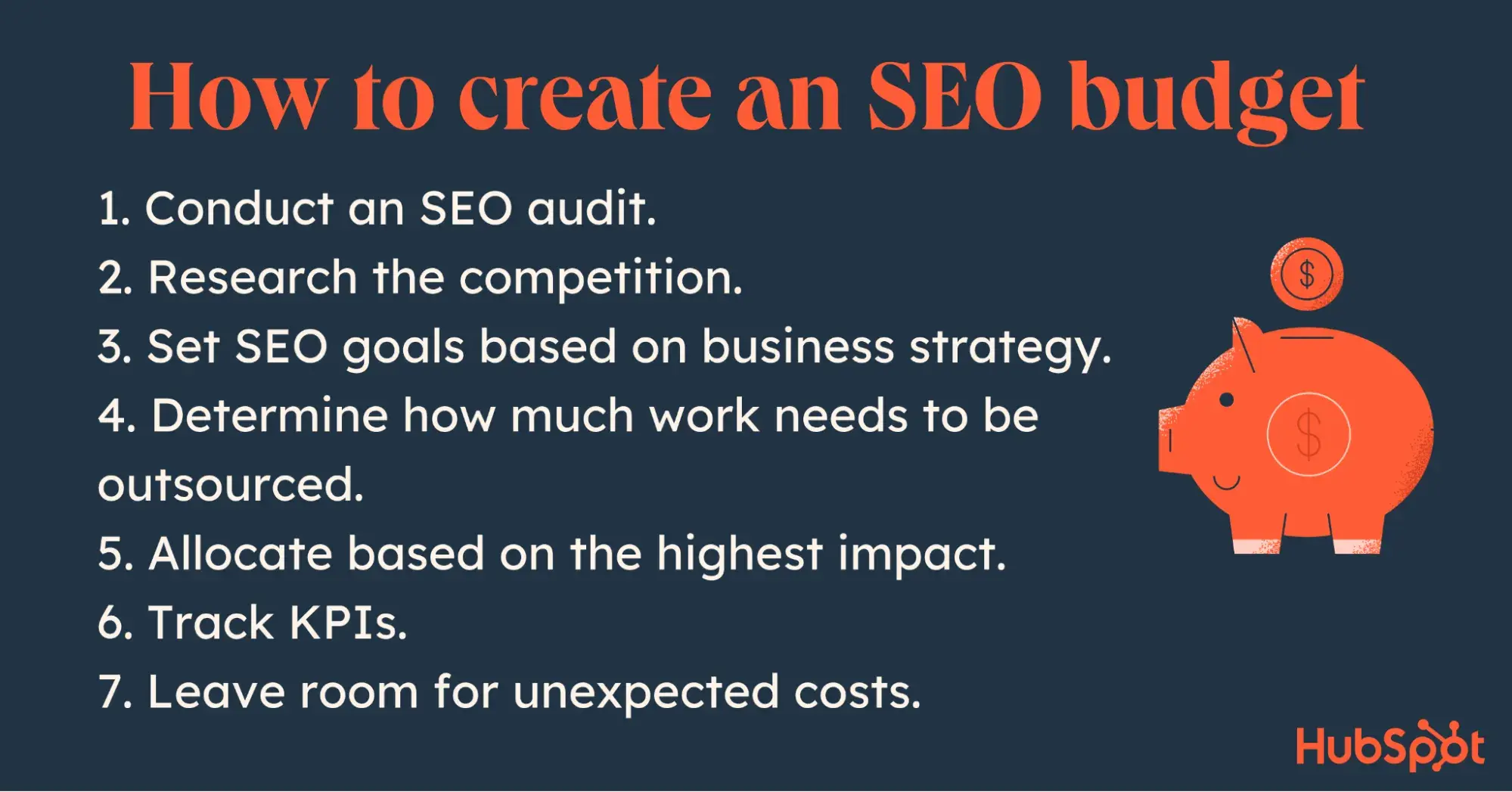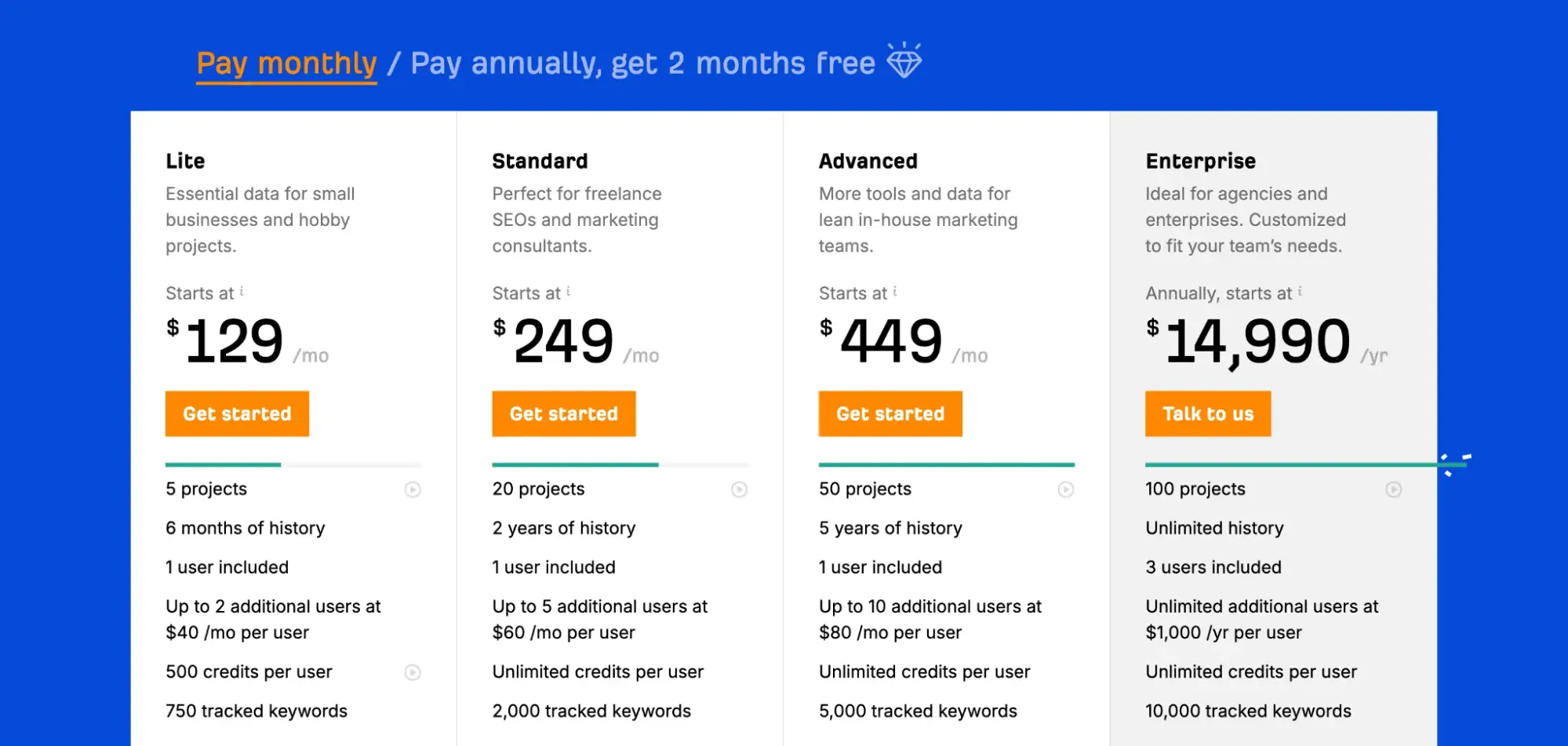I work in and around SEO on a daily basis. And although I’m on the content creation side of things, I can tell you with certainty that SEO budgets impact every part of the process.

It’s obvious to me when companies have a clear SEO budget and when they don’t.
The ones that do have an organized list of target keywords and a carefully laid out plan for ranking for those keywords — from content creation for landing pages and blog posts to building a backlink strategy.
They also have tools and services set up to help them along the way.
Marketers who want to improve their SEO and maximize their efforts must have an SEO budget in place.
Let’s review how to create an SEO budget for maximum ROI.
In this article:
The Importance of Creating an SEO Budget
A well-rounded SEO strategy involves a range of tactics, most of which fall under one of these categories:
- On-page SEO. Focuses on content and page optimizations that help a site rank for certain keywords.
- Off-page SEO. Focuses on backlinks to the site, which contribute to domain authority.
- Technical SEO. Includes backend components such as site speed, page loading time, and site codes.
The purpose of an SEO budget is to determine how much money should be allocated to each category. Without a budget, you risk overspending your resources on a tactic that might not have a strong ROI for your business.
Or worse, tactics that put your business at risk.
For example, if you don’t have money set aside to improve your domain authority through quality backlinks, you may be tempted to resort to shady link-building practices. This can put your website in hot water as Google has a policy that prohibits spammy link practices like buying or selling links.
Or, let’s say you don’t have part of your budget allocated to content creation and decide to rely solely on AI tools to generate SEO content for your website.
Well, let’s just say that creating AI-generated content at scale can have its downsides.
Here are a few more reasons why creating an SEO budget is important to your overall strategy.
You can prioritize the tactics with the most impact.
Not every business needs to spend money on every SEO tactic. Your money is best spent on the strategies you know will be most impactful.
That’s not to say you shouldn’t spend money experimenting with other tactics.
But when you know which areas drive the most results for your business, you can focus your money and efforts there while allocating a little money to other areas you’re interested in trying.
It keeps you on track to meet your goals.
If an SEO strategy is the guide, then SEO budget is the enforcer. Having a clear budget laid out prevents you from haphazardly spending money on SEO without a plan.
When you have a set budget for your SEO efforts, it’s easier to stay on track with the goals you created. Think of it this way: If you’ve set aside money in your personal budget for a gym membership, you’re more likely to exercise, right?
When you know that part of your budget is going toward the gym, it’s easier to motivate yourself to go, which helps you meet your health goals.
The same can be said about your SEO budget. When you know you’ve allocated $500 towards keyword research tools, then you’re going to take advantage of everything those tools have to offer.
It helps you track ROI.
Tracking your performance is essential for any marketing activity, and SEO is no exception. When you have an SEO budget, it’s even easier to understand each tactic’s ROI.
For example, when you know exactly how much you spent on link building and content optimizations for the month, you can calculate the ROI to see which activity was most beneficial.
From there, you can determine which activity was most successful and refine your budget as necessary.
How to Create an SEO Budget
Since I’ve never created an SEO budget myself, I reached out to the experts. Here are the steps they recommend for creating one.

1. Conduct an SEO audit.
The first step is to conduct an SEO audit.
Audits are a necessary part of any new strategy or budget planning. They help you identify where your SEO is excelling and what needs improvement.
Take a look at all areas of your SEO performance, from keyword rankings to site speed to domain authority.
Once you know what’s working well or what needs attention, you can determine where the budget should be allocated.
2. Research the competition.
After you’ve audited your own performance, it’s time to see how your competitors are doing.
Not only does this help you see how they’re ranking or which keywords they’re targeting, but this step can also help you identify opportunities they aren’t addressing.
If you’re a newer business competing with legacy businesses with strong domain authority, it might not be feasible to outrank them for certain keywords right out of the gate.
However, there may be different opportunities you could aim for, suggests Alan Muther, a digital marketing specialist and founder of Ardoz Digital: “If it looks like your competitor is killing it with content marketing, it might be smarter to double down on link building instead of trying to outdo them in content right off the bat.”
3. Set SEO goals based on business strategy.
It’s also important to align your SEO budget with your current business strategy.
For example, let’s say I run a local pizza restaurant and plan to expand into new markets within the next year. I can use local SEO to get in front of my new target audiences before I open.
In other words, when you know what your business goals are, you can plan your budget around them.
4. Determine how much work needs to be outsourced.
Once you know your goals and what it takes to meet them, ask yourself: Do you have the resources internally to execute them?
Brandy Hastings, an SEO Strategist at SmartSites, a marketing agency that’s generated over $100M in sales for its clients, suggests investing in SEO tools early into the process if you don’t have the budget to outsource.
“Depending on your time and resources, [tools] could make the difference between successfully DIYing your SEO and keeping it in-house instead of outsourcing to expensive freelancers or agencies,” says Hastings.
However, SEO campaigns can take a lot of time and resources, so it isn’t always feasible for an in-house marketing team to handle it all — especially when you have other marketing activities on your plate.
Think about your SEO goals and which tactics you want to focus on. Consider what your expertise is and which tactics may be stronger if you handed them off to an expert.
For instance, if you want to improve your domain authority through quality backlinks, you might want to hire a PR firm to help secure thought leadership opportunities. Speaking as a former PR person, I can tell you that media outreach is a specialized skill that’s definitely worth outsourcing.
5. Allocate based on the highest impact.
To maximize ROI, you should start by allocating your money to areas with the highest impact.
For example, let’s say you already have a strong content marketing engine and are ranking for several target keywords. It might be worth it to double down on creating SEO blog posts to improve your rankings if you already have a chance of reaching the top spot in the SERPs.
Another example would be if you’ve identified keywords that your competitors aren’t using. You could target these keywords for pay-per-click (PPC) to get ahead of the competition.
Budgeting is a numbers game and it may take some adjusting to get to the right formula. But if you focus on impact, you can get the most out of your money.
6. Track KPIs.
Tracking your performance can help you refine your spending.
This is why it’s important to have an analytics dashboard where you can keep an eye on all of your metrics in one place. Once you see what has a positive ROI and what isn’t working as well, you can refine your spending.
Keep in mind that SEO is a long game. Hastings emphasizes that it can take months to see results, and marketers shouldn’t be hasty about switching tactics if the initial outcome isn’t what they expected.
“If you quit after two months because the needle hasn’t started moving and you need a return today, you’ll be tossing your efforts down the drain,” Hastings says. “Consider how you’ll balance the need for more revenue now and invest in PPC to supplement your traffic until you’re bringing in enough organically.”
7. Leave room for unexpected costs.
SEO is an ongoing investment. While a budget can help guide your process, you should also leave room for unexpected costs.
From AI content making its way into search to Google’s frequent updates, marketers are familiar with how quickly the search algorithm can change. Make sure you’re prepared to adjust your content optimizations to meet those updates.
Pro tip: A common mistake is to set a fixed percentage of your total marketing budget for SEO.
According to Muther, “this isn’t the best approach because different stages and channels might need different funding levels, and these needs can change over time. For example, early on, it might make more sense to invest more in social media or content marketing to build up your presence.”
4 Costs to Consider When Creating an SEO Budget
1. Tools
SEO tools are essential throughout the process. Tools like Semrush and Ahrefs can help you research keywords, track your site‘s and competitors’ rankings, and generate content ideas.
Some are free but have limited features, while others have a more powerful paid version.
Google Analytics, for example, is free to use, while Semrush and Ahrefs are paid tools. Plans for these tools cost anywhere from $130-$500 per month.

If you’re working with a limited budget, HubSpot offers a free SEO Starter Pack which includes expert insights and an on-page SEO template.
2. Services
If you choose to outsource any of your SEO efforts, make room in your budget. SEO pricing ranges depending on what services you need and how much work is involved.
For example, you may want to focus on technical SEO and on-page optimizations in-house, but want to hire an SEO agency to help with link building or content marketing to improve keyword rankings.
Once you know which elements you want to outsource, get some quotes so you know how much to allocate for your budget.
3. Maintenance
As I mentioned before, SEO is an ongoing investment. Your SEO strategy will require maintenance and adjustments based on campaign performance, algorithm updates, and competitor performance.
4. Content creation
Again, if you want to outsource any part of your content creation — case studies, blog posts, industry reports — factor that into your budget.
This is especially important if you have a small marketing or SEO team. You may have big goals, and those goals may require additional support, tools, and services to be achieved.
Getting the Most Out of Your SEO Budget
My biggest takeaway is that if you want to get the most out of your SEO budget, you can’t skip the planning and research steps.
If I were to create an SEO budget today, I’d spend the most time on auditing and competitive analysis.
I’d dig deep into my past performance to conduct a comprehensive SEO audit, and check out all of my competitors’ SEO activity to compare. I’d use SEO tools to uncover keyword opportunities, and use templates to organize my findings.
Following these steps ensures you’re creating an SEO budget with max ROI, and that’s what every SEO marketer dreams of, right? Take advantage of tools, auditing, and services to get the most out of your SEO budget in 2024.
Credit: Source link










